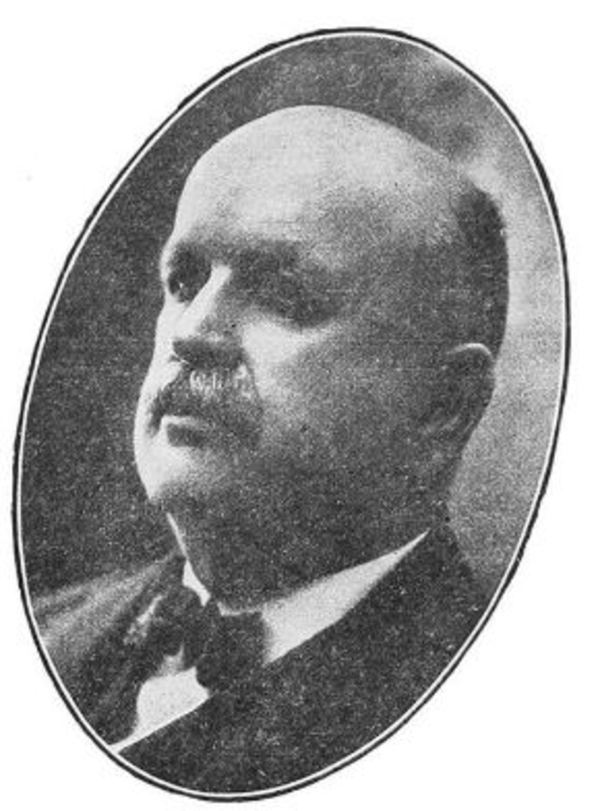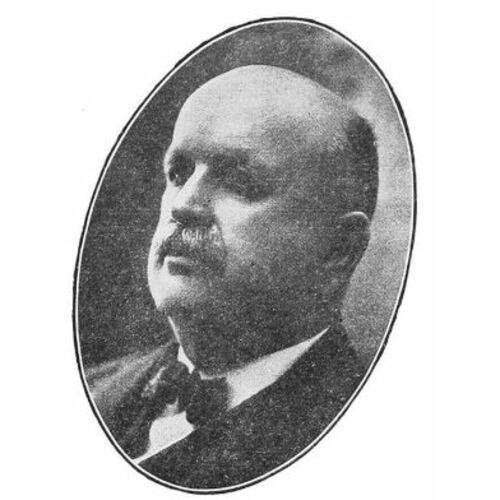
Source: Link
McAVITY, GEORGE, businessman; b. 21 July 1853 in Saint John, son of Thomas McAvity and Isabella Sandall; m. 1 Feb. 1887 Ida Marguerite Mills (1866–1928) in New York City, and they had two sons and one daughter; d. 25 April 1933 in Saint John.
George McAvity, born into an Ulster Methodist family that had emigrated from Ballyshannon (Republic of Ireland) to Saint John in 1818, was educated at Nova Scotia’s exclusive Acacia Villa School [see Sir Robert Laird Borden]. Intended to prepare students for college, Acacia Villa also offered “a practical business education to those who desire it.” On leaving school in 1871, George went to work as a clerk in the hardware department of the firm founded by his father in 1834. Later, he was a successful commercial traveller on behalf of the company, journeying as far west as Ontario.
In 1883, after a 12-year apprenticeship, George became – like his five brothers – a partner. By then the McAvity concern had diversified into hardware manufacturing, with which it would afterwards be identified. When Thomas McAvity Sr died in 1887, according to his will all his assets were to be sold and the proceeds divided among his legal heirs. The beneficiaries renounced their rights to this inheritance so that the sons could carry on the family business, which they did with conspicuous success. When James Hendricks McAvity* and another son, Thomas Jr, as senior partners, incorporated T. McAvity and Sons in 1907, George became a director. In 1910 he succeeded Thomas as president, a post he would hold for 23 years.
McAvity’s, already national in market scope and famous for the innovative design of its valves and fire hydrants and for its advanced production technology, became even more prosperous under George’s stewardship. In 1916 a large plant was constructed on Rothesay Avenue in east Saint John to manufacture munitions for the Canadian Expeditionary Force. McAvity’s also produced shells for both the British and American armies. The plant, employing 2,500 in Saint John during World War I, effortlessly made the transition to peacetime operations, and in 1929 McAvity’s abandoned marketing altogether in order to concentrate exclusively on wholesale hardware manufacturing. The firm maintained offices from Quebec City to Vancouver, and its provision of locomotive parts for railway companies across North America brought George McAvity into contact with the magnates heading these concerns; among his closest friends was no less a figure than Sir Henry Worth Thornton, president of Canadian National Railways. Such connections drew McAvity himself into the railway business in an executive capacity.
Indeed, unlike his siblings, who limited their business activities to the family firm, George ranged far afield. He was president of the New Brunswick Coal and Railway Company [see Lemuel John Tweedie*], the Edmonton, Yukon and Pacific Railway, the Maritime Manufacturing Corporation, the New Brunswick Cold Storage Company (promoted by Sir Frederick William Borden*), and the Inglewood Pulp and Paper Company. He was also vice-president of Saint John Pulp and Paper, a director of Standard Clay Products and the Eastern Trust Company, and one of the backers of Dominion Car and Foundry (1906).
McAvity’s involvement with one business enterprise in particular, the New Brunswick Coal and Railway Company (NBCR), underlines his close ties to the provincial Liberal Party, which was then in government. The company, of which McAvity had been president and managing director since July 1904, and subsequently its general manager, had been set up in 1901 to purchase the former Central Railway. It was plagued with allegations of over-expenditure and misuse of public funds, and eventually, in May 1905, the government, with the goal of disposing of a persistent political irritant, nationalized the company and appointed McAvity and Senator George Gerald King* commissioners to run it. They remained in charge until March 1908, when the Conservatives under John Douglas Hazen came into office and they resigned.
A commission chaired by Pierre-Amand Landry* was highly critical of the Liberals’ management of the NBCR’s Central Railway, claiming that $134,035 had been misappropriated. McAvity was not one of the principal culprits, but he did not escape censure. The commission noted his failure to keep financial records and his casual attitude towards administration (“From his evidence it might be fairly gathered that he considered the position he occupied an honorary one,” despite the fact that he received an annual salary of $5,000). They also alleged that “during the time Mr McAvity was President and Commissioner his firm received large sums almost monthly for goods and materials supplied to the Railway, at prices apparently fixed by himself.” The commissioners concluded that some individuals “lent their names and allowed the moral influence of their high standing in the community to assure the Province that legitimate business methods would be followed”; they clearly had both McAvity and Senator King in mind.
In 1908, to assist the floundering Liberal government of Clifford William Robinson*, which was beset with charges of corruption, and also to deprive local Conservatives of a single partisan organ in the provincial metropolis, McAvity and John E. Moore, a Saint John lumberman, bought the Daily Telegraph and the Evening Times. McAvity and Moore remained proprietors of the newspapers until 1928. By way of quid pro quo, the 1908 federal election campaign saw the Conservatives try, without much success, to implicate McAvity in an influence-peddling scandal that had engulfed William Pugsley*, then the incumbent Liberal mp and New Brunswick’s representative in cabinet.
George McAvity (“the big boss”) was three months short of his 80th birthday when he died of heart disease and pneumonia in April 1933. He passed T. McAvity and Sons intact to his son George Clifford, the firm’s general manager; it remained in family hands until 1960 and survives today as a division of Clow Canada. Historian Carman Miller describes McAvity as a “helpful fixer … a prominent Liberal businessman from Saint John.” It is an accurate assessment. McAvity was not only a captain of industry but also a steely, uncompromising partisan adept at negotiating New Brunswick’s fractious political environment in the early 20th century.
NSA, MG 2, vols.63–223 (F. W. Borden fonds). PANB, RS71A, file 193389, George McAvity; RS141C5, F18982, no.79092. Canadian annual rev., 1905–9. L. A. Cunningham, “Brass, brains and backbone: the story of the McAvitys, of Saint John – an epic of courage, vision and determination,” Maclean’s, 1 March 1929: 19–20, 51–52. Don Hoyt, A brief history of the Liberal Party of New Brunswick ([Fredericton, 2000?]). Carman Miller, “A knight in business: some aspects of Sir F. W. Borden’s business affairs, 1896–1917,” in The enterprising Canadians: entrepreneurs and economic development in eastern Canada, 1820–1914, ed. L. R. Fischer and E. W. Sager (St John’s, 1979), 233–51; A knight in politics: a biography of Sir Frederick Borden (Montreal and Kingston, Ont., 2010). N.B., Central Railway Commission, Report (Moncton, N.B., 1909; also available at www.lib.unb.ca/Texts/NBHistory/Commissions/ES45/pdf/es45r0.pdf). T. McAvity and Sons, Limited, Eighty-four years in public service: the story of an honourable business career in the city of Saint John … 1834–1918 (Saint John, [1918]).
Cite This Article
Barry Cahill, “McAVITY, GEORGE,” in Dictionary of Canadian Biography, vol. 16, University of Toronto/Université Laval, 2003–, accessed December 28, 2025, https://www.biographi.ca/en/bio/mcavity_george_16E.html.
The citation above shows the format for footnotes and endnotes according to the Chicago manual of style (16th edition). Information to be used in other citation formats:
| Permalink: | https://www.biographi.ca/en/bio/mcavity_george_16E.html |
| Author of Article: | Barry Cahill |
| Title of Article: | McAVITY, GEORGE |
| Publication Name: | Dictionary of Canadian Biography, vol. 16 |
| Publisher: | University of Toronto/Université Laval |
| Year of publication: | 2020 |
| Year of revision: | 2020 |
| Access Date: | December 28, 2025 |



